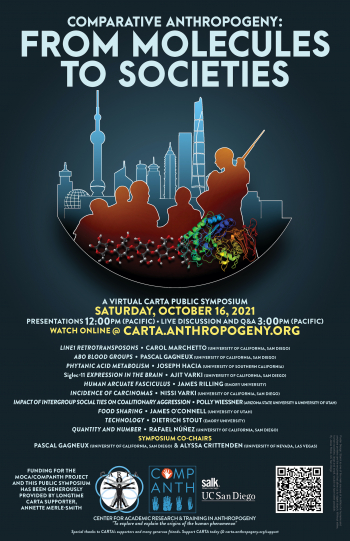Comparative Anthropogeny: From Molecules to Societies
Pascal Gagneux, UC San Diego
Alyssa Crittenden, University of Nevada, Las Vegas
Summary:
This symposium addressed several important distinctly human characteristics that ranged from molecules, to metabolism, anatomy, disease, and behavior. Goals included transdisciplinary interactions, improved self-understanding, promotion of ethically sound studies to explain known differences, and the generation of new, potentially unexplored, insights on uniquely-human specializations. Given the interest in understanding our evolution, this symposium also helped to organize how and in what sequence distinctly human physical, mental, social, and cultural features evolved. Such understanding may help explain the origin of our species and how it came to now directly shape the planet, giving rise to the Anthropocene (a proposed geological epoch distinguished by human influence on climate and the environment).
 The CompAnth series gathers dedicated CARTA Members and MOCA entry editors for discussions regarding humans and our closest evolutionary cousins (chimpanzees, bonobos, gorillas and orangutans i.e, "great apes"), with an emphasis on uniquely human features. These insights form the foundation for CARTA's "Matrix of Comparative Anthropogeny" (MOCA)" online resource and planned ebook entitled, "Comparative Anthropogeny (CompAnth)."
The CompAnth series gathers dedicated CARTA Members and MOCA entry editors for discussions regarding humans and our closest evolutionary cousins (chimpanzees, bonobos, gorillas and orangutans i.e, "great apes"), with an emphasis on uniquely human features. These insights form the foundation for CARTA's "Matrix of Comparative Anthropogeny" (MOCA)" online resource and planned ebook entitled, "Comparative Anthropogeny (CompAnth)."
Initial funding for the MOCA/CompAnth project and for this public symposium was generously provided by late CARTA Major Sponsor Annette Merle-Smith. Additional support for this symposium was provided by CARTA Patrons Ingrid Benirschke-Perkins and Gordon Perkins, Eli Shefter and Elizabeth Lancaster (in honor of Pascal Gagneux); as well as by CARTA Friends Kathlyn Furr, John Sterling, Donald and Caroline Stewart, and many generous CARTA supporters like you!
Media for each talk can be played by clicking on icons in the table below, or by clicking on the individual talk titles below and then the attachment file at the bottom of the page.
| Speakers | Media | Session |
|---|---|---|
 Ajit Varki  Alyssa Crittenden |
|
Welcome & Opening Remarks |
 Carol Marchetto |
|
LINE1 Retrotransposons Identifying cellular and molecular differences between human and non-human primates is essential to the basic understanding of the evolution and diversity of our own species. Preserved tissues are the main source for most comparative studies between humans, chimpanzees (Pan troglodytes) and bonobos (Pan paniscus). However, these tissue samples do not fairly represent the distinctive traits of live cell behavior and are not amenable to genetic manipulation. We propose that induced pluripotent... read more |
 Pascal Gagneux |
|
ABO Blood Groups ABO Blood groups represent the first described human molecular polymorphism. The ABO gene encodes variants of a protein (a glycosyltransferase) that produces the short sugar chains on glycoproteins and glycolipids that define the A, B, or O antigens. These antigens are found on red blood cells, plasma glycoproteins, and other cell types in various tissues. Individual humans can have one of four blood types based on the two alleles inherited from both parents at the ABO locus: blood type A, B,... read more |
 Joseph Hacia |
|
Phytanic Acid Metabolism Diet has played a major role in the evolution of human and non-human primate digestive systems. Phytanic acid is a potentially toxic branched chain fatty acid that can be acquired in humans by ingesting plant and/or animal products. In ruminants, the fermentation of ingested plant materials by gut microbes can liberate phytol, a constituent of chlorophyll, which can be rapidly metabolized to phytanic acid and stored in fats. Members of the marine food chain can accumulate phytanic acid by... read more |
 Ajit Varki |
|
Siglec-11 Expression in the Brain Sialic acid-recognizing immunoglobulin-type lectins (Siglecs) are a family of cell surface proteins prominently expressed on immune cells in mammals. The extracellular N-terminus of Siglecs has an Ig-like V-set domain involved in sialic acid recognition, followed by a variable number of C2-set domains; and intracellular domains with inhibitory or activating signaling that regulate intracellular responses. Sialic acids are nine-carbon backbone acidic monosaccharides found primarily in animals of... read more |
 James Rilling |
|
Human Arcuate Fasciculus Language is a human cognitive specialization, and as such, is expected to be supported by human neurological specializations. The arcuate fasciculus is a white matter fiber tract that connects Wernicke’s and Broca’s language areas in the human brain, and also connects the homologues of Wernicke’s and Broca’s areas in non-human primate brains. Damage to the human arcuate fasciculus is implicated in multiple linguistic functions. In contrast to chimpanzees and macaques, the human arcuate... read more |
 Nissi Varki |
|
Incidence of Carcinomas During embryogenesis, the three germ layers (endoderm, ectoderm, mesoderm) differentiate into epithelial and non-epithelial cells, which eventually form differentiated tissues and organs . Epithelial cells arise from stem cells and often line body surfaces that interact directly with the environment. The type of epithelium reflects location and function. Epithelial cells are typically attached to underlying connective tissue by a basement membrane, and the underlying stroma includes blood... read more |
 Polly Wiessner |
|
The Impact of Intergroup Social Ties on Coalitionary Aggression Intergroup coalitionary aggression is a vast and sensitive topic. Here I will limit the discussion to the impact of mutually supportive intergroup ties on aggression in small scale societies. Unlike our closest primate relatives, chimpanzees and bonobos, humans form strong intergroup ties which can mitigate coalitionary aggression and make peace possible. However, such bonds can also be used to build to larger alliances that take such conflicts to a new level of magnitude, supported by... read more |
 James O'Connell |
|
Food Sharing Humans are unusual in that we depend on shared foods. We also differ from other great apes in our early ages at weaning, late ages at maturity, short birth intervals and survivorship decades past menopause. Emergence of these patterns, probably in tandem, was crucial to early human evolution. Explanations focus on an ancestral shift to sharable but difficult-to-acquire foods not previously taken by hominins. I evaluate two alternatives in light of observations among modern East African hunter-... read more |
 Dietrich Stout |
|
Technology Technology is clearly central to human life and evolution but remains hard to define and study. This talk is an evolutionarily motivated definition of technology that highlights three key features: material production, social collaboration, and cultural reproduction. The broad scope encompassed by this definition respects the complexity of the subject but poses a challenge for theoretical unification. Addressing this challenge requires a comparative approach to reduce the diversity of real-... read more |
 Rafael Núñez |
|
Quantity and Number Humans and many other species have biologically endowed abilities for discriminating “quantities” to some degree (e.g., subitizing), but only humans, via the distinct capacity of “symbolic reference” exhibit “number” — i.e., exact symbolic quantification. To compare human and non-human animal data in some meaningful way, a crucial distinction between “quantical” (e.g., quantity discrimination) and “numerical” (exact, symbolic) cognition is needed: quantical cognition provides biologically... read more |
 All Speakers  Margaret Schoeninger |
|
Question & Answer Session and Closing Remarks |
| Attachment | Size |
|---|---|
| 441.98 KB | |
| 3.24 MB | |
| 108.75 KB |
If you enjoy this event, please consider supporting CARTA's quest to explore and explain the human phenomenon.


